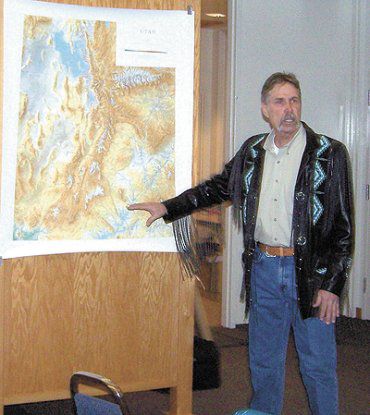Most people think the first explorer down the Green River to pass through the site of Green River City was John Wesley Powell but William Lewis Manly visited the area 20 years before Powell’s historic passage.
Attendees to the the Emery County Historical Society on Jan. 22 at the San Rafael Museum met guest speaker Dr. Michael Kane, Ph.D.
Kane has dedicated many years of research to Manly and his adventures in the Emery County area.
Dottie Grimes Director of the Emery County Archives introduced Dr. Kane.
Dr. Kane is a former resort owner at Jackson Hole, Wyo. and a river rafter on the Snake and Green rivers. Currently, he is teaching at the University of Utah, College of Health, Parks and Recreation. He is also the general manager of the Zion Ponderosa Ranch Resort, near Mount Carmel.
William Lewis Manly’s 1849 expedition from the Lumbard crossing on the Green River in Wyoming down the Green River to Green River, Utah by wooden canoe is an exciting adventure related by Dr. Kane.
On Aug. 5, 1849 William Lewis Manly and a group of seven men left the Jefferson Hunt Wagon train in hopes of traveling down the Green River to the Colorado River to the California gold fields.
Details of the trip can be read in the book titled From Vermont to California, by William Lewis Manly. He was the first American to travel down the Green River and left his note in the rocks along the Green River.
Manly’s trip occurred 20 years before John Wesley Powell explored the Colorado River.
Manly was a trapper from Wisconsin and knew about building canoes out of logs. He and his men built three canoes 16 feet long and 3 feet wide to carry the men and provisions.
As they started into the Flaming Gorge they discovered a cache of tools and a note, telling the explorers the river was too dangerous and to turn back. This did not deter Manly and his men as Manly had experience traveling on rivers.
They traveled through Flaming Gorge past the Duchesne River, Ashley Falls, Steam Boat Rock and near the Yampa River they saw mountain sheep on the hillside. They encountered rocks many times and had to portage over and around the rocks as the river was low.
When Manly and company reached Green River they met Chief Wakara or Chief Walker about three or four miles above present day Green River in September 1849.
Chief Wakara was camped on the Spanish Trail crossing of the Green River. He greeted the men and traded with them. From Chief Wakara they obtained two horses and were told which trail to walk to get to Hobble Creek which is now Spanish Fork.
Wakara controlled all the land in and around Utah and exacted tribute or a tax from any travelers up and down the Spanish Trail to California.
It took them 10 days to walk from Green River to Spanish Fork or Hobble Creek. Leaving Green River through Buckhorn Flat and up one of the canyons near Orangeville or Huntington they arrived on top of the mountain where they met Indians from Chief Wakara’s band gathering food for the winter. They then walked across the mountains and down Spanish Fork Canyon.
When they arrived Sept. 30, 1849 at the Mormon Fort at Hobble Creek they were nearly naked as the trip had worn out their clothes and shoes. There they again joined the Jefferson Hunt Wagon Train and started for California.
William Lewis Manly and his men traveled 430 miles in 48 days. Dr. Kane has retraveled the river and land mentioned to photograph or redocument the things noted in Manly’s book
Manly also wrote a book about Death Valley 1849 where part of the Jefferson Hunt Wagon Train lost their lives. Manly was able to bring help to some of the survivors in Death Valley.
Dr. Kane had a topographical map of Utah to illustrate where the rivers and mountains were and where the Manly’s expedition took place.
He also had a 10 foot long chart showing encounters with Chief Wakara taken from journals of people traveling to or through Utah. Chief Wakara and his people joined in the festivities at the first July 24 celebration by Brigham Young and the settlers.
First explorer to Green River was Manly

"Dr. Michael Kane addresses the historical society on the Manly trip down the Green River."
